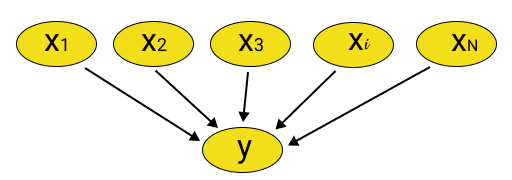Generalized Canonical
Version: 1.0.0
Pattern language family: BN
Modeling phase:
2. The conceptualization phase of a system of interest
3. The technical implementation
4. QA/QC
Modeling step:
5. Choice of how model structure and parameter values to be determined
7. Identification of model structure and parameters' values
9. Quantification of uncertainty
Problem: Increased complexity of a node (increased number of parameters) due to being the child of several nodes. This happens when a variable has several possible causes. In this case the number of parameters for the node representing a variable $y$ that has $N$ parents:
\[T_y = S_{y} \cdot \prod_{i=1}^{N} S_{x_i}\]Where:
$T_y:$ number of parameters to define for the node representing $y$
$S_y:$ The number of states for the variable $y$
$S_{x_i}:$ The number of states for the $ith$ parent $x_i$ of the variable $y$
Solution: The solution for this problem is to do the following:
Describe the variable $y$ using a NoisyOR function with the parameters assigned to each parent $x_i$ representing the probability that this parent alone will cause the respective state of $y$. Then for each state of $y$ define a leak factor $l$ representing the probability that a latent variable (other than the parents defined in the model) is causing this respective state of $y$.
Applying this solution will reduce the BN complexity as the number of parameters for the node representing the variable $y$ will be reduced to:
\[T_y = S_y \cdot \Sigma_{i=1}^{N} {S_{x_i}} + S_y\]Structure: The structure for this solution is as follows:

Fig.1 The model structure when node $y$ is defined as a NoisyOR node.
Constraints:
The constraints for this solution are as follows:
- Each of parent variables should has a probability $p_i$ of being sufficient to produce the effect in the absence of all other parents.
- The parent variables are independent.
Related patterns: NA
Design choice and model quality:
- 2.F
Resources:
- Henrion, M. (2013). Practical issues in constructing a Bayes’ belief network. arXiv preprint arXiv:1304.2725.
- Dıez, F. J., & Druzdzel, M. J. (2006). Canonical probabilistic models for knowledge engineering. UNED, Madrid, Spain, Technical Report CISIAD-06-01.
- Hossain, N. U. I., Jaradat, R., Hosseini, S., Marufuzzaman, M., & Buchanan, R. K. (2019). A framework for modeling and assessing system resilience using a Bayesian network: A case study of an interdependent electrical infrastructure system. International Journal of Critical Infrastructure Protection, 25, 62-83.
- Magrini, A., Luciani, D., & Stefanini, F. M. (2016). A Generalization of the Noisy-MAX Parameterization for Biomedical Applications. DISIA Working Paper 2016/06, University of Florence, Italy.